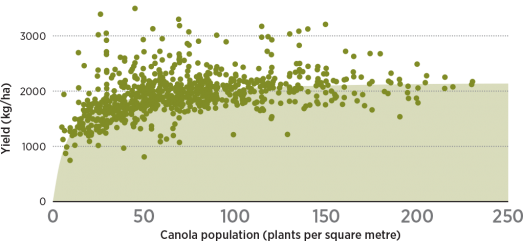Yield drops with fewer than five plants per square foot
Key Practice: Analysis of 35 canola seeding rate studies shows that hybrid canola can achieve its yield potential when at least five plants per square foot survive to harvest.
Project Title, Lead Researcher: “Determining the economic plant density in canola,” 2009, Steve Shirtliffe, University of Saskatchewan
Grower Organization Funder: ACPC, SaskCanola
This meta-analysis of 35 previous canola seeding rate studies concluded that crops with fewer than 50 plants per square metre (about five per square foot) almost always have yield.
The objective of this study was to conduct a meta-analysis of canola seeding rate and plant population trials to determine the optimum seeding rate and plant population. A meta-analysis statistically combines the results of several studies to increase the inference of the results.
Summary data from 35 experiments was included in the dataset, which comprised 176 site-years of experiments. Categorical analysis comparing yields of approximately 3 kg/ha (roughly 3 lb./ac.) versus 5 kg/ha (roughly 5 lb./ac.) determined that canola seeded at 5 kg/ha had, on average, a four percent higher yield than canola seeded at 3 kg/ha. Site years with the greatest yield reduction were those in which the emergence of the 3 kg/ha treatment was lower than 45 plants per square metre (or about 4.5 per square foot).
A second analysis examined the effect of canola population density on yield. In general, hybrid canola reached its maximum yield at lower densities than open pollinated canola. Hybrid canola achieved 90 percent of its yield at 45 plants per square metre. Even plant populations of hybrid canola
as low as 15 plants per square metre produced 70 percent of the maximum achievable yield.
But caution should be used when planting hybrid canola at very low densities because only five site-years in the study explored the effects of canola populations below 10 plants per square metre. Further research is needed.
When choosing a seeding rate, note that the yield loss from a lower seeding rate depends on field emergence. At high field emergence rates, and therefore higher canola populations, yield loss caused by reducing the seeding rate from 5 kg/ha down to 3 kg/ha is not great. For example, if the emergence of the canola at the lower rate is 80 plants per square metre, then this resulted in a predicted yield loss of only three percent. However when the emergence of canola is low, reducing seeding rates results in greater yield losses. Seed weight will also influence the plant population.
Conclusion
One could argue that when the seeding rate of canola was first deter-mined the seed cost was incidental. This meant that producers could afford to seed at a much higher rate than was needed to maximize yield. Higher seed costs have put more emphasis on the seeding rate decision.
Hybrid canola appears to maintain a large proportion of its yield at low plant densities, although very few studies at the time of this meta-analysis had low canola densities. Economically it is more profitable to seed canola at lower rates when seed costs are high, and when the selling price and yield of canola is low. However reducing seeding rates increases the risk of lower plant populations, which can result in large yield losses. Emergence is often low in canola, so reducing seeding rates is a risky decision.
Canola farmers seeking to maximize returns should target populations greater than 50 plants per square metre (five per square foot). Plant populations lower than this will almost always have yield loss.





